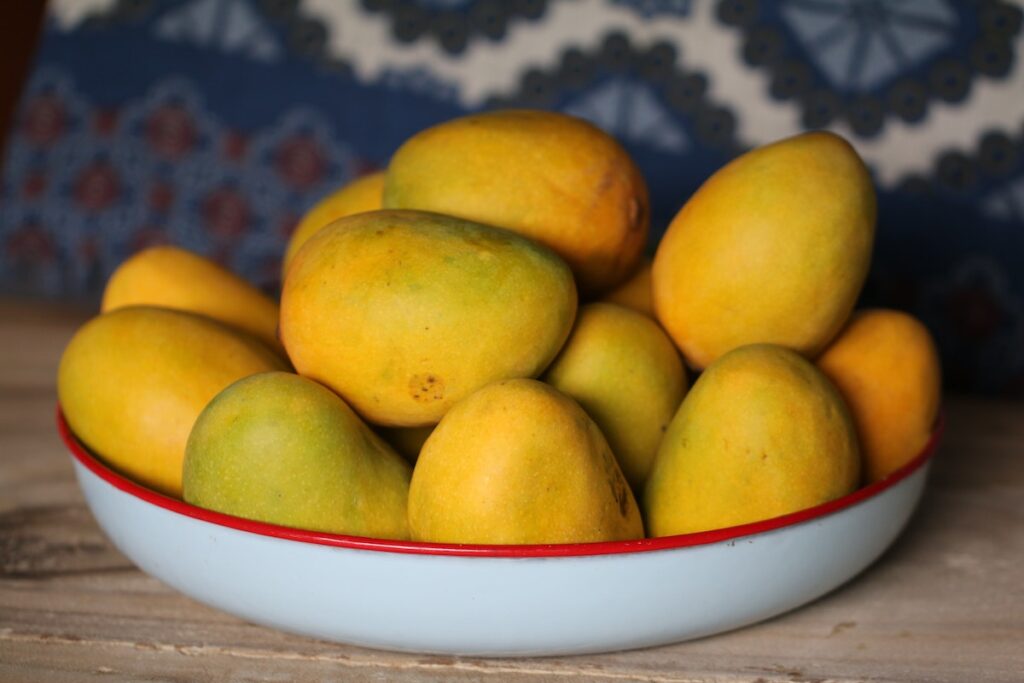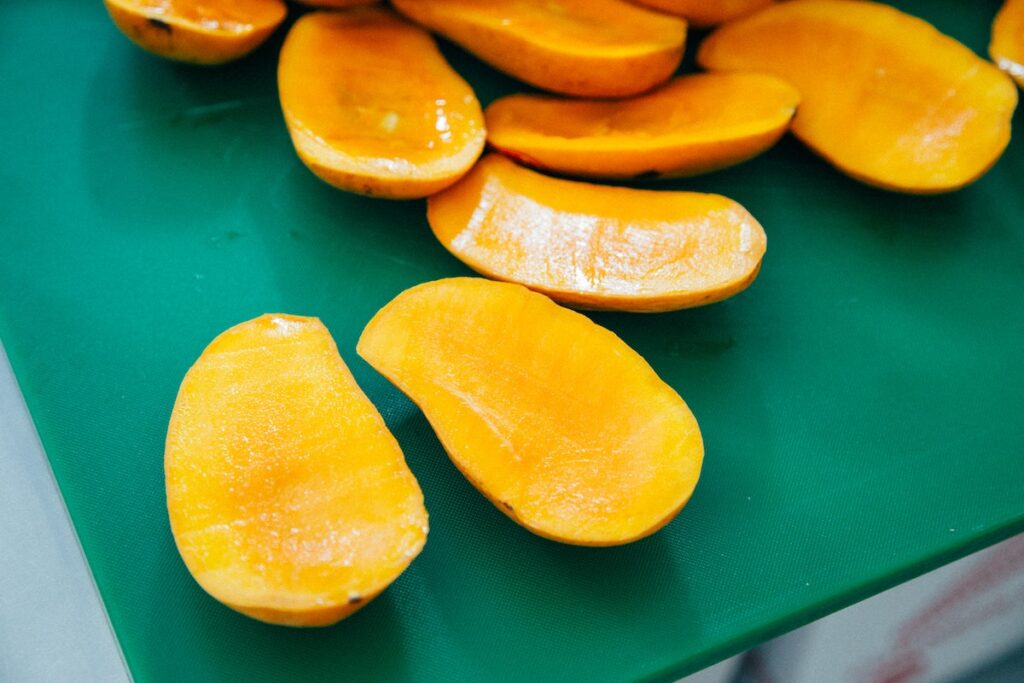Can dogs eat mango?
Mango is a sweet and delicious tropical fruit that comes in hues of pale yellow, gold, green, and orange. They’ve been referred to as “the king of the fruits” because they’re one of the most popular, nutritionally rich fruits available!
This is most evident during the summer months when mangoes are ripe and in season, and their flesh is super sweet and juicy. It makes them hard to resist, for both humans and dogs.
But are they safe for canine consumption? And if so, are they a healthy treat? The answer is yes, with some caveats. Read on to learn all about the risks and benefits of mangoes for dogs.
Can dogs have mangoes?
Yes, your dog can eat mango! Mangoes are high in fiber and come packed with nutritional benefits, making them a great alternative to traditional dog biscuits, which are oftentimes full of chemical preservatives.
Additionally, they’re sweet and have soft, tasty flesh, so your dog is bound to find them drool-worthy.
As with any fruit though, you’ll want to feed your dog mango in moderation and introduce the fruit slowly to ensure your dog has no adverse reactions. Don’t forget – always speak to your vet before introducing new foods into your pet’s diet.
And, we can’t leave out the fact that there are certain things to take note of before you start cutting your dog a slice. There are a few downsides to mangoes that you need to keep in mind. Let’s flesh this out!

Are mangos good for dogs?
Yes, mangoes are good for your dog. When eaten in moderation, there are many health benefits to be gained by feeding your dog mango.
Plus, mangoes are a great substitute for store bought treats since they contain no preservatives, harsh chemicals, or artificial sweeteners or flavors.
Mangoes are a great source of the following:
- Fiber: Promotes healthy bowel movements, colon health, and relieves your dog of constipation. It also aids in weight management.
- Vitamins A, C, E, and B6: These healthy vitamins promote sharp eyesight (especially in senior dogs), improve your dog’s skin and coat, and aid in the proper functioning of the kidneys, liver, and lungs. They also help reduce inflammation and cognitive aging, and are essential for cell function and fat metabolism.
- Antioxidants: Mangoes are high in beta-carotene and other antioxidants that help boost your dog’s immune system and defend against degenerative diseases, skin problems, allergies, and even certain types of cancer.
- Protein: Mangoes contain protein, which can help with muscle repair and other important body tissues.
- Minerals: Mangoes are high in minerals like potassium, which helps muscle development, supports healthy kidney and heart function, and improves bone density.
Besides offering a nutritional boost, mangoes are fat, sodium, and cholesterol-free! It’s no wonder they’re called “the king of the fruits.”
Are mangoes safe for dogs to eat?
Mangoes are safe for your dog to eat, as long as they’re prepared properly.
Mango is a stone fruit, similar to apricots, peaches, and cherries, meaning that the fruit has an outer, fleshy exterior that surrounds a single shell with a seed, also known as a pit or stone.
You’ll want to ensure the pit is removed, as well as the tough skin, and that you’re dishing up only the sweet, soft mango flesh for your dog to eat.
Additionally, be cautious of how much mango you feed your dog – you don’t want to overdo it. Mangoes are high in fiber and sugar, so feeding too much mango – or feeding mango too regularly – can cause stomach issues or even dental decay.
Despite these serious caveats, when served properly, mango is a delicious and healthy treat for your dog!

How much mango can my dog eat?
To learn the specific quanity of mango appropriate for your pet, speak to your veterinarian. They’ll be able to advise you on how much is ok for your dog to eat, depending on their size, breed, and general health.
According to the United States Department of Agriculture, one cup of mango contains 99 calories and 22.5 grams of sugar. Fresh mangoes are about 14% sugar by weight!
Fruit-based sugar is ok for your dog, but only in moderation – too much of it can lead to adverse health effects, like obesity or tooth decay.
Mangoes are also very high in fiber, so eating an excessive quantity can cause digestive issues like diarrhea or an upset stomach. Dietary fiber is good for dogs, but only in moderation.
A good rule of the thumb is to follow the 90/10 rule, where 90% of your dog’s calories come from healthy, balanced meals, and 10% come from treats. Since mango is considered a treat, it should be part of that 10% of your dog’s daily food consumption.
Ultimately, your vet is the best resource to determine how much mango your dog can eat based on their weight, size, and medical history.

Can dogs eat mango skin?
Mango skin, also known as mango peel, is not safe for dogs. It contains urushiol, a component also found in poison oak and poison ivy. Should it touch your dog’s skin, there’s a chance it’ll cause a rash or irritation.
Plus, mango skin is tough and leather-like, making it hard to chew and digest. If your dog eats it, it can lead to an upset stomach, vomiting, or intestinal blockage.
Peel the mango before feeding it to your dog, and make sure the skin stays out of reach of your dog.
Can dogs eat mango pits?
Mangoes contain a flat, oblong pit with a fibrous, hairy surface. You might think they’d make a good chew for dogs, but it’s best to keep mango pits away from your dog.
Mango pits pose a serious choking hazard. If your dog does manage to chew, break, and swallow a pit, then pieces can get stuck in their digestive tract. This can cause life-threatening issues, and require surgery.
It’s also worth mentioning that, like other stone fruits, mango pits contain trace amounts of cyanide. It’s released if your dog manages to chew, crush, or grind up the pit. While it’s not a large enough amount to seriously harm your dog, it’s still not healthy, and why take the risk?
If your dog ingests a piece of mango pit, there’s a solid chance they’ll be fine. But you might still want to contact your vet, just in case. You’ll need to keep an eye on your dog for a few days and make note of anything out of the ordinary.
It’s better to be safe than sorry, so don’t let your dog have access to mango pits!

Can dogs eat dried mango?
Dried mangoes are super tasty, but they also tend to be high in sugar, calories, and carbohydrates, especially if commercially bought. This can cause an stomach upset, diarrhea, or tooth decay.
The drying process also deprives the fruit of some of its health benefits, meaning that dried mango won’t pack the same nutritional punch as its fresh counterpart.
Stick to fresh mango when it comes to feeding your dog. If you really want to give them a taste of dried mango, then consider trying organic dried mango, with no additives, or making your own.

Can dogs eat mango ice cream?
Who doesn’t love ice cream? It’s cold, creamy, and sweet. Add in mango flavor and you’ve got yourself a super tasty treat. But the truth is, ice cream should only be an occasional treat for humans, and probably shouldn’t be given to your dog at all. The added sugar is bad for both your dog’s stomach and their figure.
Even if you make your own ice cream at home, the recipe will most likely include additives like sugar that your dog shouldn’t have.
Skip the store bought mango ice cream. But not to worry, you can still give your dog a taste of healthier versions of dog-friendly ice cream made at home.
Try mixing mango purée with organic plain yogurt and freezing it! It’s a dog-friendly version that your dog is sure to enjoy, especially during the hot summer months.
Can dogs eat mango sorbet?
It depends!
Sorbet is a cold, sweet treat, similar to ice cream. The main difference between the two frozen favorites are the ingredients: sorbet is dairy free, while traditional ice cream is made with dairy.
While people like to think of sorbet as ice cream’s healthier cousin, the truth is that while sorbet is dairy free, it is still high in sugar, often more so than ice cream.
So, your dog should probably skip the sorbet – they don’t need the extra calories!
If you’re keen on your dog having a healthy frozen treat, consider freezing some mango purée in an ice cube tray. This version of dog-friendly mango sorbet is healthy, easy to make, and refreshing on a hot day.

Can dogs eat mango yogurt?
It depends.
Store-bought mango yogurt usually contains artificial flavors and preservatives, which can be bad for your canine companion. It might even contain artificial sweeteners like xylitol, which can be toxic for dogs. Those sugary, store-bought yogurts have little nutritional value.
If you want to feed your dog mango yogurt, the best option is to prepare it yourself. Combine plain yogurt with organic mango flesh for a dog-friendly version. Be sure to give your dog a little bit of yogurt first to see how they handle it.
Feed the homemade yogurt to your dog in moderation. You can have them to lick it, add it to a Kong, or freeze it in ice cube trays.
Can dogs eat mango chutney?
Mango chutney is a tangy, tasty condiment that’s often served with meats or cheeses, or spread in sandwiches. It’s full of flavor, and super delicious, so it’s understandable that your dog will want a lick. But unfortunately, it’s best to keep the chutney to the humans.
Mango chutney often contains ingredients like nigella seeds, garlic, and ginger, among other herbs and spices. It’s a hodgepodge of delicious ingredients that may not sit well in your dog’s stomach.
Keep the chutney to yourself and stick to fresh mango for your dog.
Can dogs eat mango Italian ice?
It’s probably best for your dog to skip the mango Italian ice. Italian ice is a refreshing frozen treat made with water, sugar and flavoring – that’s right, it’s mango flavoring, not actual mango.
While they’re delicious, the truth is Italian ices have no nutritional value. The added sugar and artificial flavoring can upset your dog’s stomach or cause diarrhea. Skip the Italian ice altogether.

Are mango leaves poisonous to dogs?
Similar to mango skin, mango leaves contain urushiol, an oily mixture of organic compounds that has been known to cause allergic reactions. It’s unknown how your dog will react if they ever come in contact with mango skin or leaves, but better safe than sorry – it’s better to keep them out of reach.
As far as poisoning goes, in the early 1900s cows were fed mango leaves and thought to have died from possible urushiol poisoning. As a result, the practice was outlawed in 1908.
While eating a plethora of mango leaves might make your dog sick, a leaf or two should be ok, should your dog get loose near a mango tree. If this happens, contact your veterinarian and monitor your dog for any sort of reaction.
Can dogs eat mango sticky rice?
Say those three magical words, mango sticky rice, and my mouth begins to water. This traditional Southeast Asian dessert is sweet, easy to eat, and super delicious. It’s made with glutinous rice, fresh mango and coconut milk, and eaten with a spoon or your hands.
While I’d never turn down some mango sticky rice, it’s best not to give any to your dog. The dessert contains sugar, typically palm sugar, which serves no purpose in your dog’s diet.
Plus, it can cause a stomach ache or diarrhea if they gobble down too much. Since mango sticky rice is hard to resist, don’t let your dog give in to temptation, and keep it away from them.

How to feed your dog mango
I wish it were as simple as tossing your dog a mango and calling it a day, but unfortunately, you’ll have to do a bit of prep work before feeding your dog mango.
Here’s how to safely serve your dog mango:
- Check the mango to make sure it’s ripe. Pick a plump, fragrant mango that feels heavy for its size. To determine if the mango is ripe, apply firm but gentle pressure to it; if it gives slightly when squeezed, it’s ripe and ready to eat!
- Wash and rinse the mango. Rinse the mango thoroughly to wash off any bacteria, pesticides, or dirt.
- Slice one side of the mango. Hold the mango with the stem end up, and make an initial cut slightly off center so you miss the pit.
- Slice the other side of the mango. Hold the mango firmly and slice the other side of the mango. You will now have three parts – two fleshy, plus the middle section with the pit.
- Cut the peel from the pit. Take the middle section with the pit and thinly cut away the peel with your knife. Then cut the remaining flesh off or eat it yourself right off the pit. Be sure to discard the pit and peel in a place that’s out of reach of your dog. Compost them!
- Scoop or score. With your two remaining halves, either scoop out the flesh with a large spoon or score the two fleshy parts into cubes. Cubes are great for bite-size pieces! When scoring, cut through until your knife reaches the peel. Be sure to discard the peel!
- Enjoy! Supervise your dog as they consume the juicy, delicious treat.
Tip: You’ll want to make sure you feed your dog small enough mango pieces so they’re not a choking hazard. Mangoes can be quite large, so make sure to cut them into small, bite-sized pieces before serving. This is especially important when dealing with puppies and/or small dogs.
Once your mango is cut, there’s a myriad of ways your dog can enjoy it. Here are a few ideas:
- Fresh: Fresh mango is a tropical, tasty treat that you and your dog can enjoy together.
- Frozen: Freeze the mango to make a refreshing, tasty snack. You can freeze mango in thin slices, in cubes, or in an ice cube tray with yogurt. Perfect on a hot summer day!
- Food Topper: Liven up any meal with mango as a food topper. It’s a simple way to serve your dog mango – sprinkle bite sized pieces in their food dish.
- Puréed: Puréeing mango will make it easy for senior dogs, and those with few teeth, to eat. It’ll also make mixing the sweet treat with other foods – like yogurt or dog kibble – easy. Try it in a Kong!
- Mango Sorbet: Mix puréed mango with water and freeze it in an ice cube tray to make a dog-friendly version of mango sorbet.
- Cheesy surprise: Stir mango, either puréed or in pieces, into some cottage cheese for a delightful snack.
- Dehydrated mango: Dehydrated mango slices make a great treat while on-the-go or on a hike. They’re easy to make and store.
As always, check with your veterinarian before introducing any new foods to your dog.







